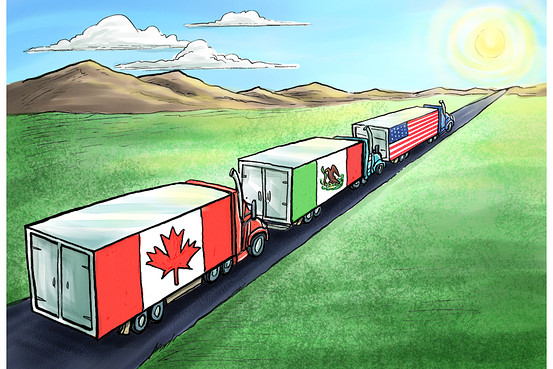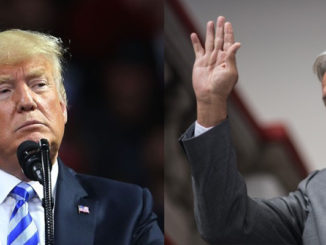
by George P. Shultz
Discussions of rising economies usually focus on Asia, Africa and the BRIC countries—Brazil, Russia, India and China. But what may well be the most important development of all is often overlooked: the arrival of North America as a global powerhouse. What’s going on?
The North American Free Trade Agreement was signed by U.S. President George H.W. Bush, Canadian Prime Minister Brian Mulroney and Mexican President Carlos Salinas in 1992. It was ratified in the U.S. thanks to the leadership of President Bill Clinton in 1993. Since then, the integration of the three economies has proceeded at a sharp pace.
Consider:
The three countries constitute around one-fourth of global GDP, and they have become each other’s largest trading partners. Particularly notable is the integration of trade. A 2010 NBER study shows that 24.7% of imports from Canada were U.S. value-added, and 39.8% of U.S. imports from Mexico were U.S. value-added. (By contrast, the U.S. value-added in imports from China was only 4.2%.) This phenomenon of tight integration of trade stands apart from other major trading blocks including the European Union or East Asian economies.
Tighter trade integration has been accompanied by a staggering level of legal movement of people. Total intra-North America movement is 230.8 million annually—over half stemming from same-day travel between the U.S. and Mexico alone. Looking just at overnight tourism, Canadians made 21.3 million trips to the U.S. in 2011 and spent $23.9 billion. U.S. visitors made 11.6 million trips to Canada and spent $7.7 billion. Mexican visitors made 13.5 million trips to the U.S. and spent $9.2 billion. U.S. visitors made 20.1 million trips to Mexico and spent $9.3 billion. (Mexico is the top outbound destination of U.S. travelers.) Legal border crossings for trucks in 2010 amounted to 10.7 million between the U.S. and Canada, and 9.5 million between the U.S. and Mexico.
The three Nafta countries together account for $6.63 trillion in total exports and imports. They have among them free-trade agreements with 50 other countries and there is massive overlap among them. The U.S. is now engaged in negotiations for a free-trade agreement with Europe. Mexico already has such an agreement, and Canada is close to one.
North America, with the U.S. in the lead, is the world’s center of creativity and innovation. Any measure will do: new companies formed, Nobel Prizes received, R&D spending, attractiveness to high talent from anywhere, patents issued, and numbers of great universities.
Meanwhile, the energy picture is being transformed by the innovative use of horizontal drilling in the process called fracking. North America is on its way to being a net exporter of energy. The implications for geopolitical developments are vast. North America will have security of supply no matter what happens in the Middle East or elsewhere.
Meanwhile, the North American energy trade is itself notable: $65 billion annually between the U.S. and Mexico and over $100 billion annually between the U.S. and Canada. Cross-border infrastructure and markets for crude oil, refined products, natural gas and electricity increasingly enable the integration of both conventional and emerging forms of energy across the three economies.
Even more important than fracking are the potentials for new ways of producing energy and ideas for using energy more effectively. The promise of these new developments will emerge from the research and development under way at universities and companies in North America. Much of this research is funded by a combination of government and industry money. When good ideas do emerge, the system means that organizations are on hand that know how to scale and commercialize them. Through this R&D, North America can lead the way to a more environment-friendly outlook for the production and use of energy.
The fundamental determinant of productivity of people stems from their education. In the U.S., Canada and Mexico, there is a wide disparity in average K-12 achievement scores, even though, in all three countries, there are plenty of examples of outstanding schooling. In math, Canada is clearly and by far the best of the three countries in K-12 education. The U.S. lags considerably behind Canada, and Mexico is even further behind.
There are continuing efforts in all three countries to improve performance, and the potential for raising living standards is enormous. If the K-12 attainments of students in the U.S. and Mexico were to rise to the level in Canada, the average paycheck in the U.S. could grow by 20% per year. In Mexico, the increase in the average paycheck would be off the charts.
Addictive drugs present our continent, particularly the U.S. and Mexico, with a pressing problem. Every aspect of their use and sale has been criminalized in the U.S. The results are high prison rates in the U.S., high profits for drug dealers, and criminal activity in Mexico, Central and South America as drug cartels, with money and guns from the U.S., wreak havoc in many countries. Deaths in Mexico associated with the drug war have been estimated at around 60,000 over the past five or six years.
The U.S. should vigorously adopt the view expressed by Nancy Reagan in her address to the United Nations in 1988. She said that “if we cannot stem the American demand for drugs, then there will be little hope of preventing foreign drug producers from fulfilling that demand. We will not get anywhere if we place a heavier burden of action on foreign governments than on America’s own mayors, judges, and legislators.”
There needs to be an open debate on this subject in the U.S. and with our North American partners. We should examine the efforts by other countries and find better ways to deal with this savage problem.
Concerning immigration in North America, it should be noted that with fertility in Mexico declining, and an expanding Mexican economy that is now more than competitive with China in many ways, net immigration of Mexicans to the U.S. last year was zero. Meanwhile, approximately 70% of the people who work on farms in this country are immigrants, legal and illegal. The U.S. needs them. All this underlines the importance of sensible reform in the U.S. immigration system.
People often ask me what Ronald Reagan would think of this or that subject. In the case of immigration, we don’t have to speculate. On Jan. 19, 1989, in his last formal statement at the White House, he said:
“We lead the world because, unique among nations, we draw our people—our strength—from every country and every corner of the world. And by doing so we continuously renew and enrich our nation.
“While other countries cling to the stale past, here in America we breathe life into dreams. We create the future, and the world follows us into tomorrow. Thanks to each wave of new arrivals to this land of opportunity, we’re a nation forever young, forever bursting with energy and new ideas, and always on the cutting edge, always leading the world to the next frontier.
“This quality is vital to our future as a nation. If we ever closed the door to new Americans, our leadership in the world would soon be lost.”
Mr. Shultz, a former secretary of labor, Treasury and state, and director, Office of Management and Budget, is a distinguished fellow at Stanford University’s Hoover Institution.
follow us on facebook and twiiter



